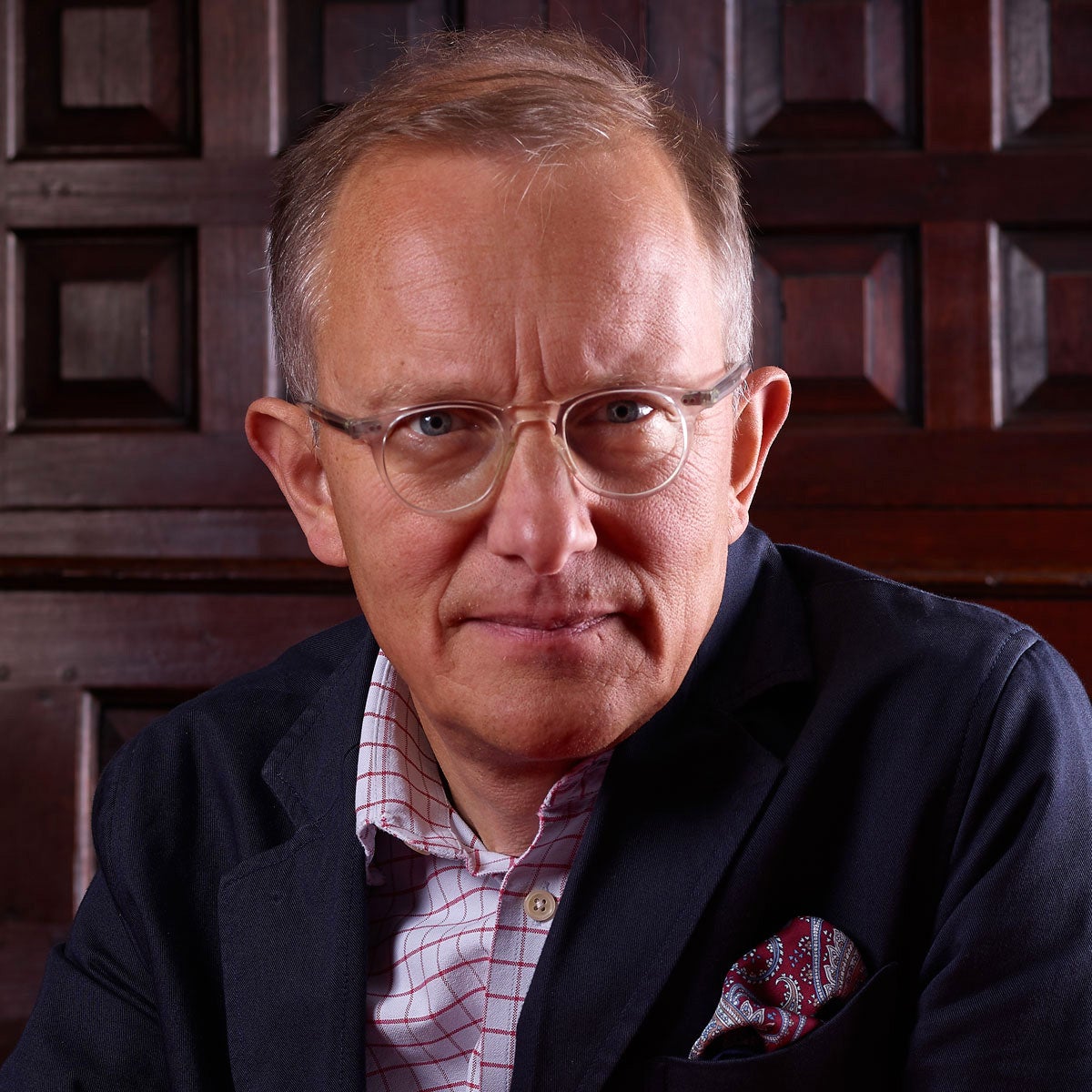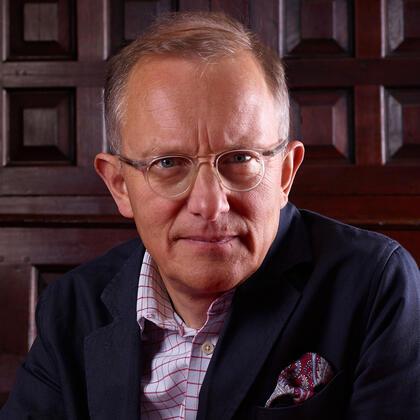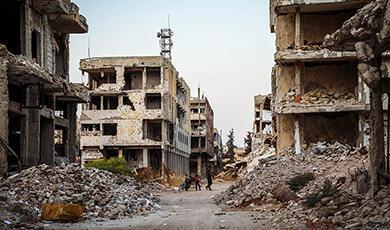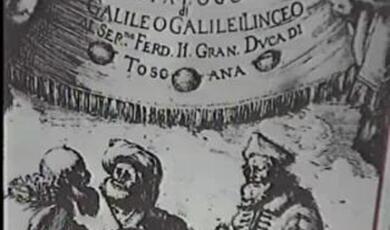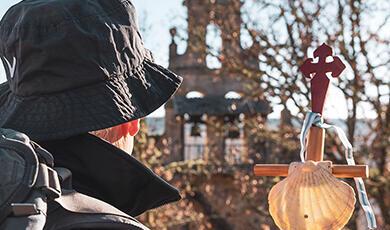The Politics of Architecture in Tudor and Stuart London
Share
- Details
- Text
- Audio
- Downloads
- Extra Reading
How the Tudor and Stuart monarchs used the buildings of London to boost their power and influence.
Download Text
Professor Simon Thurley
Visiting Gresham Professor of the Built Environment
11/12/2010
Tonight, and again on the 11 March, I will be looking at the interrelation of architecture and power. The power of kings and the power of government and how that power has affected London. On the 11th I will be looking at Victorian and Edwardian London but tonight I'm going to concentrate on the sixteenth and seventeenth century and show how Tudor and Stuart Monarchs used, with varying degrees of success, the great buildings of the City of London to bolster their power.
The story of royal buildings in the City starts with the Saxons. Before 1052 English Kings had had a palace in London at Aldermanbury, but principally to avoid the instability, turbulence and violence of the populace Edward the Confessor, the penultimate English King, had moved his royal palace one and a half miles west to an Island called Thorney. On Thorney Island the Confessor built the great royal abbey and palace of Westminster. And it was here, that William the Conqueror chose to be crowned on Christmas day 1066, safely away from the still hostile inhabitants of the city.
London was too big, powerful and independent to be much influenced by the Norman Conquest. Business continued unabated under a deal done between the city rulers and their new king. However William left a major legacy by establishing the metropolitan geography of the English monarchy - the subject of my talk this evening.
In the east he built a great tower in the corner of the Roman wall, this was balanced in the same position in the west by another and a third tower at the city's western gate. In the midst of these was founded a great new cathedral on the site of an earlier Saxon church. These buildings were designed to overawe and dominate what one contemporary chronicler called 'the fickleness of the vast and fierce populace'.
The White Tower in the eastern corner of the city was more than a fortress, it was a palace - still equipped today with a magnificent chapel, fireplaces and latrines. The Conqueror was clearly intending to live closer to his people than his predecessors, but only in the most stoutly defended residence with walls 13ft thick.
Norman St Paul's has, of course, gone. It was begun in 1087 and became perhaps the second largest Christian church in Europe. It was spectacularly sited on a hill and eventually crowned by Europe's tallest spire. It became the icon of London. While Westminster was to be the site of every subsequent coronation and, in due course, the royal mausoleum, St. Paul's articulated the relationship between the monarch and his subjects, the largest group of which lived under its shadow. It was the biggest covered space in England and became the setting for great national moments and the reception of dignitaries from abroad.
Today it is hard to visualise how geographically separate the Tower, St. Paul's and Westminster were. Until the mid seventeenth century the city was still surrounded by a wall and a ditch, which was in places some 200ft wide. To get to it from Westminster it was necessary to set off along King street, turn right at Charing Cross and travel the mile and a quarter along the Strand and Fleet Street to cross the River Fleet and enter the city. This was a long route. Once in the city you would climb a steep hill to St. Paul's precinct before entering the bustling shopping street of Cheapside and travelling to the conduit head at poultry. This was the densest part of the city crammed with shops, halls and houses hugger mugger. From here the route passed down Lombard Street and Fenchurch Street before cutting across to Tower Street and arriving at the western approaches of the tower.
This route was like the bar of a great royal dumbbell with weighty royal residences at either end. The Tower of London fitted tightly onto one end of the dumbbell. Modern Great Tower Street called 'Tower Street' in the middle ages, is theatrically aligned on the White Tower which presents one of its two architecturally enlivened facades to the city. Edward I rebuilt the whole of the western side of the Norman fortress, but continued to mark the axis down Tower Street from the city by the construction of the massive Beauchamp Tower. So the Tower of London was deliberately designed and developed to present a ceremonial front to the city and to lock itself into Tower Street.
At the other end of the dumbbell was Westminster. Although Westminster developed as the largest of the royal houses from the time of the conqueror its political supremacy was not really properly consolidated before Edward the first, second and third had subdued the Scots. But by the middle of Edward III's reign the political gravity of England had moved decisively to Westminster. Henceforth this was to be the normal meeting place of parliament and the principal residence of the monarch.
On 17 July 1377 King Richard II was crowned King at Westminster Abbey. This coronation marked a deliberate shift in the way the monarchy, in Westminster, presented itself to the people, in London. There were special circumstances surrounding the coronation of a ten year old boy, especially against the background of the young king's all powerful uncle John of Gaunt. But we can probably credit John of Gaunt with the invention of the coronation procession, a major feature of almost every subsequent coronation until 1661.
There had been processions on the eve of coronations before, in 1236 and 1308 for instance, but never formally integrating the city Aldermen and mayor. The procession worked like this: The great magnates and Lord Mayor and Aldermen met uncrowned the new ruler outside the city and escorted him to the Tower. The monarch would then spend the night in the fortress and the next morning a great procession formed around the uncrowned king. Leaving the tower, the procession then rode through the city, along the ceremonial route that I have described, to Westminster Hall. The citizens of London would decorate their houses, hang tapestries from the windows and in later periods would sometimes create ephemeral arches and other decorations en route. The novelty of Richard II's 1377 procession was the intimate involvement of the city and the outburst of civic pageantry that accompanied it.
Coronation processions acted as a bond not only between the City Corporation and the crown, but as a bond between the crown and the people. It was also one of the few public ceremonial uses of the Tower, emphasising majesty of the royal citadel. During the fifteenth and sixteenth century all monarchs and many consorts had coronation processions. By the time of Richard III's coronation in 1483 the so-called 'little device', a coronation manual, gives full instructions for the nature of the procession setting the tone for the coronation processions of the Tudor age.
I have already mentioned, in passing, the role of St. Paul's cathedral lying on the royal route between the tower and Westminster. It was the Lancastrians who capitalised on the cathedral as the amphitheatre for public royal ceremonial in the city. John of Gaunt, that great promoter of royal civic ceremonial chose to be buried in the cathedral in 1399, the same year in which Richard II's body was displayed there so that all could see that he was dead; Henry V gave thanks for his victory at Agincourt in St Paul's and on his death lay in state there; following the defeat of Lambert Simnel a great celebration was held there by Henry VII. Prince Arthur and Katharine of Aragon were married at St. Paul's; in 1518 and again in 1522 Henry VIII celebrated great diplomatic alliances there. After the defeat of the Spanish Armada, Queen Elizabeth knelt before the west doors of the cathedral giving thanks to God before being escorted inside by fifty clergy in full vestments to hear a sermon.
So the Lancastrians, Yorkists and Tudors used St Paul's as the public arena for the monarchy at moments of triumph or when public statements needed to be made. As often as not these occasions were accompanied by a formal entry like that at a coronation.
Processions and entries into the city also increasingly became part of the structure of diplomatic protocol as the sixteenth century wore on. In fact by the middle of James I reign the royal processional route from the Tower to Westminster was an integral part of ambassadorial etiquette. Ambassadors generally arrived by sea at Gravesend and from there would proceed to Greenwich and then on to the Tower. Under James I this became a highly formalised route. At the Tower the ambassador would be met by a fleet of carriages which would transport him along the ceremonial route to Westminster. These magnificent welcomes, which utilised the king's carriages, and were performed by senior courtiers and the monarch's own entries had an international aspect. After the gunpowder plot, James I welcomed his reception in the city saying that these 'signs were the more welcome for that foreign ambassadors might see the vanity of those reports that were spread abroad in other countries of mislikes and distastes between him and his people'.
So Westminster, St. Paul's and the Tower and the streets between them were a string of pearls to be worn by monarchs to emphasise their majesty, assure loyalty from the populace, a bond with the city oligarchs and to send signals abroad. The intention was, to quote one Elizabethan, to convert London 'into a stage wherein was showed the wonderful spectacle of a noble hearted princess toward her most loving people, and the people's exceeding comfort in beholding so worthy a sovereign'.
All this was undertaken knowingly. It was an investment, financial and political on the part of the city and the monarchy. The court was faced with huge bills for the cost of liveries, banners, drums, horse trappings and the like, and the city for mass refreshments for the population and the decorations that adorned the royal route. The Duke of Newcastle had told his ward Prince Charles 'what protects you kings more than ceremony' The distance people are with you, great officers, heralds, drums, trumpeters, rich coaches.... I know these master people sufficiently. Even the wisest shall shake off his wisdom and shake for fear of it, for this is the mist that is cast before us and masters the commonwealth?
At this point I think its important to stress that it was only with the stability afforded by the Tudor monarchs that this mutual admiration and respect could arise. In some senses this began with Henry VII's triumphant entry into London in 1485, when he was met by the mayor and aldermen and escorted to St. Paul's where in front of the people he gave thanks, but the turning point, as with so much else comes with Henry VIII.
During Henry VII's reign a community of interest grew between the Crown and London that was to last the whole sixteenth century. Henry protected the power and privilege of the Aldermen; individual merchants were rewarded and honoured; the trading companies were awarded charters, monopolies and trading licences; London's food supplies were safeguarded and parliament was kept out of their business. In return for these royal privileges and favours the City supplied men and ships in time of war; expert personnel for government service; trade services; support in international diplomacy and of course, crucially, ready finance in the form of loans. The Aldermen also kept law and order and did their best to control outbreaks of plague.
This elision of interest has caused one historian to see the cooperation between crown and city being so close that it amounted to the establishment of a condominium. This view is reinforced by the crown's attitude to two buildings in the city. One I have introduced already, St Paul's Cathedral.
In June 1561 a disaster struck the cathedral. A bolt of lightning struck its spire turning the crowing pinnacle of the city of London into a burning pyre. The destruction of the spire and the damage it caused to the crossing and to the interior was considered a national disaster. Queen Elizabeth herself instructed the Lord Mayor and the Archbishop of Canterbury to raise money for the rebuilding. Work to re-roof the damaged part and rebuild the spire was slow and after years of nagging in 1582 she appointed one of her most senior courtiers to enquire why 'the principal ornament of the chief city of the kingdom was still in decay'.
Elizabeth failed to solve the problem and in 1608 James I wrote to the mayor and the bishop of London calling the state of the cathedral a scandal. James dearly wanted to see the restoration of the cathedral but like his predecessor a combination of money problems and a lack of leadership meant that nothing came to pass in his lifetime. In the end it was Charles I who between 1631 and 1642 succeeded in solving at least some of the problems.
Charles effectively nationalised the cathedral bypassing the bishop, dean and mayor and organising and financing work on the cathedral himself. His attention moved away from the spire and was driven by two motives; the liturgical and theological beautifying and ceremonialising programme of Archbishop Laud and his own desire for civic ornamentation. This latter desire resulted in the construction of Inigo Jones's massive classical portico topped by statues of James I and Charles I and inscribed with words glorifying the monarchy.
Royal concern with St. Paul's was matched by another building on the route from Westminster to the Tower. The Royal Exchange. The royal exchange was the bourse of London. It was built not by the crown, or even by the city but from the personal wealth of Sir Thomas Gresham. Gresham's career represents, better than almost any other, the coincidence of interest between a city merchant and the Crown. He was a merchant adventurer who was appointed the king's merchant or agent at Antwerp, becoming virtually English Ambassador to Europe and chief of the foreign intelligence service. After the death of his son and heir this merchant cum royal servant decided to devote part of his vast fortune to the construction of a bourse in the centre of London, indeed on Cornhill, slap on the processional route from Westminster to the Tower.
In January 1571 Queen Elizabeth herself attended what was effectively the opening party and was so impressed by what she saw that then and there she declared that it should be called the ROYAL exchange. But there was more to it than that. The exchange was provided with 26 life size statues of English monarchs ranged in niches round the inner courtyard. Such pantheons had appeared before in royal buildings and cathedrals. But such a thing had never been seen in a public, secular or privately constructed building before. This was an extraordinary public expression of the coeval interests of trade and the crown.
So by the reign of Elizabeth another site of symbolic importance had been added to the monarchical spine of London, a building that in its foundation and iconography proclaimed the insoluble link between the crown and the city.
The success of the Tudor management of London, its great buildings and its streets as the theatre of majesty paid dividends at least three times during the sixteenth century. The city refused to back the usurpers the Duke of Northumberland and Lady Jane Grey in 1553. nor did they rise to support Sir Thomas Wyatt's rebellion the following year. Most of all London remained loyal in 1601 when the earl of Essex attempted to rally the populace in rebellion against Elizabeth in Cheapside.
At this point this evening, if I were to conclude (which I'm not going to) I think it would be safe to say that Tudor London was an intimately royal city. Not in the way that Paris was, a contrived seat of the monarchy, but a city where the interests of the crown and the oligarchs coincided and where the populace were nurtured as loyal supporters of the dynasty. This correspondence continued under James I, particularly in his first years, but did so despite James's own preferences. James, of course, came from Scotland and the Scots way was not to be so public. Ceremonial occasions in Edinburgh were dour and private, not at all like the great Elizabethan pageants. But James I was well briefed when he arrived in London in 1603. Although he was unable to celebrate the procession at his coronation because of the plague, he returned to London the following year and even went to the Tower before processing through the city to Westminster. As he passed through the city the Recorder of the city proclaimed 'Come therefore o worthiest of kings as a glorious bridegroom through your royal chamber'. The city clearly expected to be treated as the Privy chamber of the land as it had been under Elizabeth. (The privy chamber being the king's most personal and private room, as well as his most magnificent).
But after this magnificent start James proved to be a very reluctant actor on the city stage. One contemporary pointed out sourly the comparison between James I and his predecessor. The king liked, he said, to go to the tower for baiting of Lions but when he came out 'he was so troubled with swarms that he feared to be baited by the people... He was not like the late queen of famous memory, that with a well pleased affection, met her peoples acclamations, thinking most highly of herself when she was born upon the wings of their most humble supplications'. Indeed James only made 3 formal processions through the city in person. But in the early years of his reign his lack of visibility was probably partially made up for first by Prince Henry's participation in entries and then by his brother Prince Charles. Perhaps through these James leant of the importance of such events. When he made an entry into the city in 1621 it was said that he spoke to his people 'contrary to his former hasty and passionate custom, which often, in sudden distemper would bid a pox or a plague on those who flocked to see him'
Unfortunately after his youthful appearances in the city in 1616 and 1623 Charles I had absolutely no such sense of public presence. In 1625 (the year of his accession) as in 1603, it was deemed impossible to have a coronation procession because of plague. But unlike his father he saw no hurry to be crowned. Virtually a year elapsed after James's death before Charles's coronation and then there was no procession. He simply informed the mayor and aldermen that he had 'altered his purpose': at a stroke denying the city its traditional and long held opportunity to express its loyalty to the new king. The Venetian ambassador reported the 'murmurs of the people'. In effect during the 1630s public showing of the monarch in the streets of London ceases.
The twin pillars of coincidence of commercial and political interest and the active and affectionate display of royal magnificence and participation in the city underpinned the harmonious relationship between London and the Tudor Monarchs. Under Charles I this was rapidly eroded by a series of aggressive, unpopular and provocative policies towards the corporation. It is almost certain that the damage done to relations between the crown and the city during the 1630s would have at least in part be ameliorated if Charles had presented a more sympathetic personal face to its population. Twice he promised ceremonial entries to the city, once for his coronation and once on his return from Scotland in 1633. Both times he cancelled. Certainly he beautified St. Paul's but little credit attached itself to him for this great work as its theological basis was a matter of great suspicion and dislike.
But in the period immediately before the civil war Charles Suddenly seems to have realised just how important the city was to him and to what degree his tactlessness and neglect had succeeded in battering and disillusioning it. The first signs of a reversal in his attitude came in 1638 when the King ordered a complete restoration of the White Tower at the Tower of London.
The decayed Romanesque windows were cut out and brand new round headed windows in an antiquarian sub-Norman style added. Buttresses were re-capped, blank arcading re-carved, battlements re-built and quoins replaced. All the stone work was in new glistening white Portland stone. The roof was substantially repaired and one of the iron vanes on the roof re-instated. The vanes were then painted and gilded and the whole of the outside of the Tower painted with white limewash. Finally a vast new British flag was ordered to be flown over it 'upon all solemnities and triumphs'.
This was not militarily necessary, nor can it be argued that it was a priority for expenditure on the royal residences. The work to the White Tower was in fact Charles finally coming to terms with the most important part of the monarchical backdrop to public and state occasions in the city and handing the work over to Inigo Jones himself who would make the Tower look at its best.
As this work was nearing completion Charles offered the city a whole raft of concessions and, crucially, accepted a traditional entry. In 25 November 1641 the king, on his return from Scotland, was met outside the city walls and processed through the city to the mansion house and thence on to Whitehall. The city was delighted and even presented him with a gift of £20,000 to show their loyalty. The rapprochement with the city was short-lived and as I am sure many of you will know it was ultimately the refusal of the city elite to grant Charles another loan that forced the recall of parliament.
But despite Charles's apparent comprehension of the importance of the tower, both as a visual symbol of royal authority and potentially of military importance, in 1642 he gave permission to the royalist lieutenant, Sir John Byron, (the man in charge of the Tower), to resign his post. In his stead parliament was able to appoint their own lieutenant Sir John Conyers. With the king out at Windsor and the Tower of London in the hands of the parliamentarians the London had fallen to the opponents of the Stuart regime without a shot being fired. Although Charles didn't realise it, with London under parliamentary control the civil was lost before it had even begun. When Charles eventually returned to London, it was as a prisoner about to stand trial.
So in a sense the degree to which monarchs managed London, and the great symbolic monuments of monarchy in the city, was a barometer of their success. Where the Tudors had succeeded the Stuarts Failed.
In 1643 a royalist commentator wrote 'If posterity shall ask who would have pulled the crown from the king's head, taken the government off its hinges, dissolved monarchy, enslaved the laws, and ruined the country, it was the proud, unthankful, schismatical, rebellious, bloody City of London'. Just as few historians would disagree fundamentally with the jaundiced and angry words of a contemporary royalist, so few would disagree with the proposition that the city played a major role in the restoration of Charles II. Charles II knew both these facts and they underpinned his attitude to the city and its buildings.
During the 1660s there is little doubt that Charles thought that he could merely recreate, in modern guise the monarchy that his father and grandfather had enjoyed. He was wrong. The whole household was restored, all 650 people, but in 1663 financial crisis meant that it had to be reduced in scale and magnificence. A great new palace was begun in Greenwich, largely for the reception of ambassadors, but it was abandoned on grounds of coat. And perhaps most significantly after the great fire of London in 1666 Charles was keen to rebuild London to a formal plan, but commercial interest made this impossible.
It is worth looking briefly at the two most famous proposals for rebuilding the city. This is Sir Christopher Wren's proposal for a new City. Note how the processional route from Westminster to the Tower is maintained and strengthened. Wren was a royalist and a courtier born and bred and understood these things. His route would have passed St. Paul's and made straight for the Tower. John Evelyn's proposal is similar but takes the route from St. Paul's via a great public plaza at the end of London Bridge before ending up reproducing great Tower street, the traditional processional route to the Tower.
Of course neither plan came to anything and the commercial imperative to rebuild the city, together with the complexities of land ownership, meant that London was rebuilt on the same plan as before. Of course the Great fire of London also destroyed two of the three great symbols of monarchy in the city. The tower was not affected. Now it is clear that everyone saw the royal exchange and the tower as the twin secular icons of London - images of commerce and majesty. The second triumphal arch that Charles passed under during his coronation procession was painted with views of the tower and the royal exchange on an equal basis. Thus Charles showed equal concern and interest in the design of the royal exchange and St Paul's cathedral. His interest in St. Paul's is well known, but he was also concerned that the exchange should be rebuilt magnificently and personally laid the foundation stone of the new building in 1667 before being dined, under a royal canopy in a shed set up in the ruins. The new exchange, like the old, contained a pantheon of royal statues and Charles paid particular interest in approving his own statue to stand at the entrance.
Thus during the 1660s and into the 70s Charles II was eager to reassemble the architectural backdrop to royal pageantry in the city and to rebuild loyalty to the crown through public display. But we have to remember that Restoration London was still very divided - particularly in matters of religion. This led to a stand-off between the king and parliament over the Catholicism of the king's brother and heir to the Throne, James Duke of York. (This is known as the exclusion crisis). It also led to popular fear and anxiety over catholic plots and conspiracies.
So Restoration London was pretty unstable. The Bawdy House riots of 1668, the first major political riots in London of the reign were accompanied by slogans such as 'ere long we will come and pull Whitehall down'. Hardly music to the king's ears. Much more serious was the extreme ferment in the capital caused by the Exclusion Crisis. The result of this was Charles's decision to call parliament to Oxford rather than to Westminster in 1681 depriving his opponents, the supporters of exclusion of their popular power base in the city.
Charles started to get tough with the city. After the Oxford parliament the lord mayor and aldermen came to Whitehall to read a petition to the king for the recall of parliament. The mayor, on his knees in front of a seated king on his throne surrounded by the magnificence of the court read his petition. At the end of the speech, Charles turned to the Lord Chancellor at his side and remarked that this was none of the city's business and, without turning the lord mayor, left the room. This extraordinarily crushing episode was reported far and wide with broadsheets reporting every humiliating detail. Charles then moved to deprive the city of its charter and take its governance into his own hands. Between October 1683 and October 1688 the city was run by a royal commission while the king attempted to pack city government with tory supporters of the crown. Extraordinarily to promote the city's renewed loyalty to the crown the city guilds were urged each to sponsor one of the royal statues for the new royal exchange. This they did with some squabbling over who should sponsor which monarch.
But Charles clearly had little trust that these measures would truly secure his safety and that of the monarchy more widely. The evidence for this is that he was contemplating a radical plan B. From the early 1680s Charles was contemplating moving his principal palace away from Westminster altogether and in 1683 he decided where he was going to locate it. His choice fell on the ancient English capital of Winchester in Hampshire not far from Portsmouth on the south coast.
The decision to build a new palace at Winchester broke with two hundred years of royal building which had located the crown's principal buildings in the Thames valley.
What we know of Winchester Palace leaves no doubt that it was meant to be a substantial royal residence. Its western façade was longer than the eastern façade erected in the 1690s at Hampton Court. Winchester was to have provided more royal accommodation than Hampton Court with both state apartments and privy lodgings for the king and queen as well as for the duke and duchess of York and the duchess of Portsmouth, the king's mistress. And both palaces had some 100 lodgings for courtiers. Importantly Winchester also had a council chamber and provision for Clerks of the Council. This latter point is key because the provision of so much well thought out space for the king's council sets the palace apart. Only Whitehall had such facilities, not even Windsor Castle included a council chamber, Windsor being considered (as it still is) the principal suburban retreat.
This is my recent reconstruction of Charles's plans for his new seat, and I would argue his new capital city. The palace was on a hill, and in the town was the great medieval cathedral. Between the two he proposed to cut a great processional route to be lined with the five houses of his courtiers. Here far from the risks of London, and surrounded by his loyal and adoring subjects Charles could live and process in public as his grandfather had done in London.
In conclusion, tonight I have argued that at the end of the fourteenth century, with Westminster the unopposed political and monarchical capital of England a series of ceremonies were invented and developed that emotionally and symbolically linked Londoners and the crown. These were performed on a route that ran between the two great royal palaces in London the Tower and Westminster, but by the sixteenth century equally embraced, in the city the architectural embodiment of church, commerce and state.
The Tudors worked this system with brilliance and aplomb, but the Stuarts first under James, and then Charles failed to do likewise. Charles II, although re-establishing the critical points on the royal route made plans to abandon it altogether and to create a new palace with its own integral processional route in Winchester.
Next time, on 11 March, I will move the clock on two hundred years to ask whether the Victorians appreciated the opportunities that great architecture presented to express and project power. I hope you will join me then.
©Professor Simon Thurley, Gresham College 2010
Part of:
This event was on Thu, 11 Feb 2010
Support Gresham
Gresham College has offered an outstanding education to the public free of charge for over 400 years. Today, Gresham College plays an important role in fostering a love of learning and a greater understanding of ourselves and the world around us. Your donation will help to widen our reach and to broaden our audience, allowing more people to benefit from a high-quality education from some of the brightest minds.


 Login
Login
